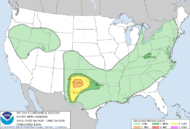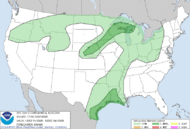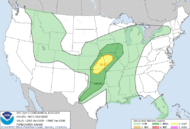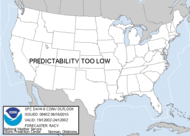 |
| Photo by Michael E. Palmer, Tuscaloosa News Michael Harris carries an unconscious Whitney Crowder, 6, through the Bear Creek Trailer Park, 12/16/2000 |
 |
| Birmingham Nexrad, 12/16/17 at 12:57 p.m., 3 minutes after tornado touched down. |
 |
| NWS Birmingham path map of 12/16/2000 Tuscaloosa tornado |

ABC 33/40 Chief Meteorologist James Spann and his team, which included meteorologists Mark Prater and John Oldshue, did an excellent job providing coverage of this storm, and were awarded an Emmy. ABC 33/40 captured the tornado on a tower camera as it moved through the southern part of Tuscaloosa. James wrote later, "Our StormChaser van was heavily damaged in the storm; John Oldshue and his photographer had to rush in to a Hampton Inn to protect themselves as the tornado passed right over their location. The manager of the motel had all of the guests lined up in a hallway on the lowest floor, and nobody was injured there." Below is video of ABC 33/40 coverage.
The screen capture below is from WVUA Tuscaloosa coverage of the tornado.

This was the strongest tornado in Tuscaloosa in at least 50 years (since 1950) and it was the strongest December tornado in Alabama since at least 1950. It was the deadliest tornado in Alabama in 2000 and tied with a tornado in Georgia as the deadliest in the nation that year. According to the National Weather Service Birmingham, "The tornado was spawned by a supercell thunderstorm that originated in Mississippi. This thunderstorm was responsible for additional tornado damage in St. Clair and Etowah counties...Tuscaloosa EMA reported 11 fatalities with this tornado along with 144 injuries. Nine of the fatalities occurred in mobile homes, one in a vehicle, and one in a commercial building converted to residential use. Six of those killed were females and five were males. Ages ranged from 16 months to 83 years old. The tornado was on the ground for a total of 18 miles, all within Tuscaloosa county. The tornado path was estimated to be 750 yards wide at it's maximum intensity." Complete storm survey information from the NWS Birmingham, including photos, can be found at this link.
Interestingly, researchers from Texas Tech University's Wind Science and Engineering Center believed that the damage was more consistent with actual wind speeds in the F2 range because the Fujita Scale did not take into account the building types nor quality of construction. This helped lead to the "Enhanced Fujita Scale' or EF scale, which became operational in the United States in 2007.
Three other tornadoes occurred in Alabama on December 16, 2000. One of those was responsible for the death of a woman in Geneva County who was thrown 75 yards from her mobile home. A total of 24 tornadoes occurred that day across the Southeastern United States.
Mike Wilhelm
@Bamawx on Twitter
Bamawx Facebook.
---









